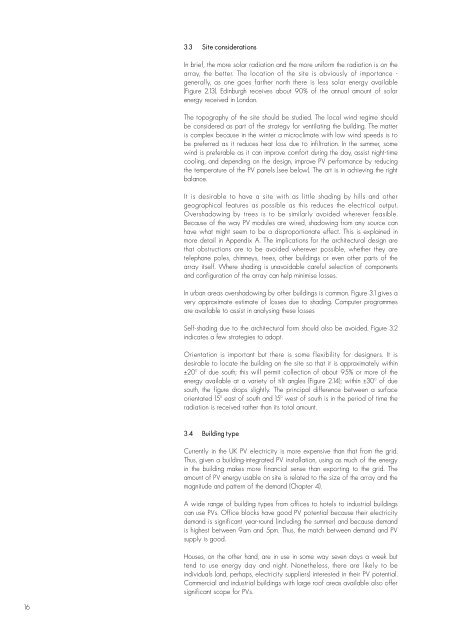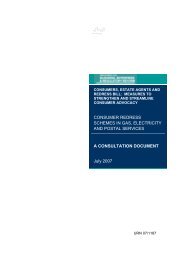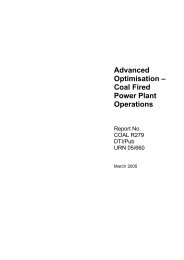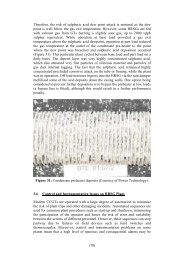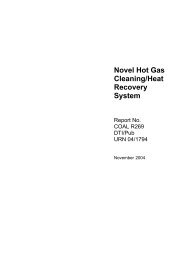Photovoltaics in Buildings A Design Guide - DTI Home Page
Photovoltaics in Buildings A Design Guide - DTI Home Page
Photovoltaics in Buildings A Design Guide - DTI Home Page
You also want an ePaper? Increase the reach of your titles
YUMPU automatically turns print PDFs into web optimized ePapers that Google loves.
16<br />
3.3 Site considerations<br />
In brief, the more solar radiation and the more uniform the radiation is on the<br />
array, the better. The location of the site is obviously of importance -<br />
generally, as one goes farther north there is less solar energy available<br />
(Figure 2.13). Ed<strong>in</strong>burgh receives about 90% of the annual amount of solar<br />
energy received <strong>in</strong> London.<br />
The topography of the site should be studied. The local w<strong>in</strong>d regime should<br />
be considered as part of the strategy for ventilat<strong>in</strong>g the build<strong>in</strong>g. The matter<br />
is complex because <strong>in</strong> the w<strong>in</strong>ter a microclimate with low w<strong>in</strong>d speeds is to<br />
be preferred as it reduces heat loss due to <strong>in</strong>filtration. In the summer, some<br />
w<strong>in</strong>d is preferable as it can improve comfort dur<strong>in</strong>g the day, assist night-time<br />
cool<strong>in</strong>g, and depend<strong>in</strong>g on the design, improve PV performance by reduc<strong>in</strong>g<br />
the temperature of the PV panels (see below). The art is <strong>in</strong> achiev<strong>in</strong>g the right<br />
balance.<br />
It is desirable to have a site with as little shad<strong>in</strong>g by hills and other<br />
geographical features as possible as this reduces the electrical output.<br />
Overshadow<strong>in</strong>g by trees is to be similarly avoided wherever feasible.<br />
Because of the way PV modules are wired, shadow<strong>in</strong>g from any source can<br />
have what might seem to be a disproportionate effect. This is expla<strong>in</strong>ed <strong>in</strong><br />
more detail <strong>in</strong> Appendix A. The implications for the architectural design are<br />
that obstructions are to be avoided wherever possible, whether they are<br />
telephone poles, chimneys, trees, other build<strong>in</strong>gs or even other parts of the<br />
array itself. Where shad<strong>in</strong>g is unavoidable careful selection of components<br />
and configuration of the array can help m<strong>in</strong>imise losses.<br />
In urban areas overshadow<strong>in</strong>g by other build<strong>in</strong>gs is common. Figure 3.1 gives a<br />
very approximate estimate of losses due to shad<strong>in</strong>g. Computer programmes<br />
are available to assist <strong>in</strong> analys<strong>in</strong>g these losses<br />
Self-shad<strong>in</strong>g due to the architectural form should also be avoided. Figure 3.2<br />
<strong>in</strong>dicates a few strategies to adopt.<br />
Orientation is important but there is some flexibility for designers. It is<br />
desirable to locate the build<strong>in</strong>g on the site so that it is approximately with<strong>in</strong><br />
±20 0 of due south; this will permit collection of about 95% or more of the<br />
energy available at a variety of tilt angles (Figure 2.14); with<strong>in</strong> ±30 0 of due<br />
south, the figure drops slightly. The pr<strong>in</strong>cipal difference between a surface<br />
orientated 15 0 east of south and 15 0 west of south is <strong>in</strong> the period of time the<br />
radiation is received rather than its total amount.<br />
3.4 Build<strong>in</strong>g type<br />
Currently <strong>in</strong> the UK PV electricity is more expensive than that from the grid.<br />
Thus, given a build<strong>in</strong>g-<strong>in</strong>tegrated PV <strong>in</strong>stallation, us<strong>in</strong>g as much of the energy<br />
<strong>in</strong> the build<strong>in</strong>g makes more f<strong>in</strong>ancial sense than export<strong>in</strong>g to the grid. The<br />
amount of PV energy usable on site is related to the size of the array and the<br />
magnitude and pattern of the demand (Chapter 4).<br />
A wide range of build<strong>in</strong>g types from offices to hotels to <strong>in</strong>dustrial build<strong>in</strong>gs<br />
can use PVs. Office blocks have good PV potential because their electricity<br />
demand is significant year-round (<strong>in</strong>clud<strong>in</strong>g the summer) and because demand<br />
is highest between 9am and 5pm. Thus, the match between demand and PV<br />
supply is good.<br />
Houses, on the other hand, are <strong>in</strong> use <strong>in</strong> some way seven days a week but<br />
tend to use energy day and night. Nonetheless, there are likely to be<br />
<strong>in</strong>dividuals (and, perhaps, electricity suppliers) <strong>in</strong>terested <strong>in</strong> their PV potential.<br />
Commercial and <strong>in</strong>dustrial build<strong>in</strong>gs with large roof areas available also offer<br />
significant scope for PVs.


